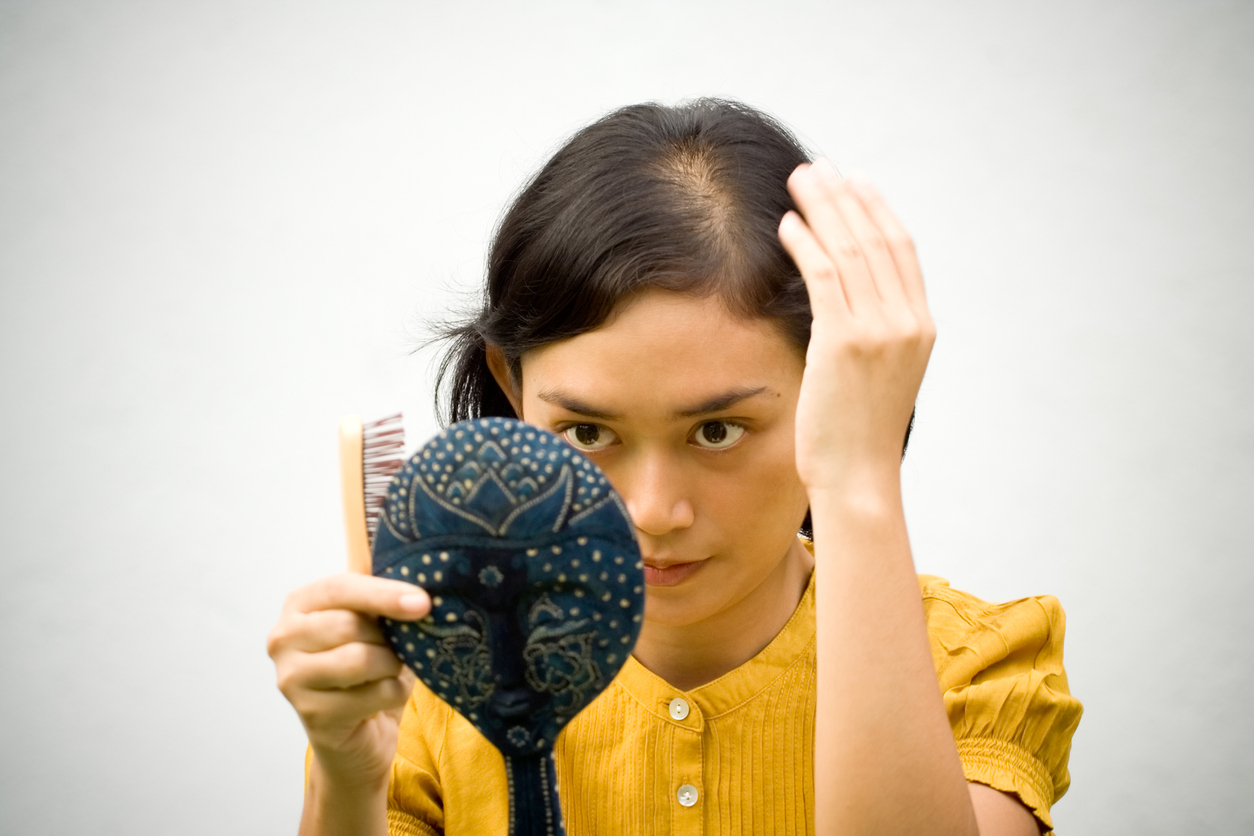Advertising Disclosure
Hair loss can be devastating for women, but there’s hope

Losing hair or finding a bald spot can be devastating, especially for women. Thankfully,the outlook is positive, with many treatments showing proven success rates. And in many forms of hair loss, growth will return on its own. So what do you do when you start noticing more hair than normal collecting in your shower drain? Or maybe you’ve noticed your ponytail seems thinner than it used to be.
Hair loss in women can cause stress and worry, but it’s more common than you might think. The truth is, we’re always losing hair. According to the Cleveland Clinic, it’s normal to lose between 50 and a 100 single hairs per day. But this normal amount of hair loss usually goes unnoticed. But what causes hair loss in women beyond the normal amount? Not all hair loss is the same, and the are various possible underlying causes. So when you do notice a sudden change or increase in hair loss, it may be time to see a doctor.
What causes hair loss in women with female pattern hair loss (FPHL)?
Female pattern hair loss (FPHL) affects about 30 million American women. And according to the American Academy of Dermatology, FPHL tends to begin in midlife, “when a woman is in her 40s, 50s, or 60s.” And unlike male hair loss, women’s hair loss tends to start near the temples and recede back. FPHL is genetic, but that doesn’t mean you can’t do something about it.
Treatment options for FPHL include the medication minoxidil (more commonly known by the brand name Rogaine), which has been used to treat male hair loss. It takes time to regrow hair, so results will not be immediately noticeable even with medication.
Unfortunately, minoxidil requires daily application to see results, and those results usually can’t be confirmed until you’ve been on the medication for about a year. Other medications that have also been shown to be beneficial are spironolactone, finasteride, flutamide and dutasteride. But all of these medications require similar timelines of six to 12 months to see results.
How can I treat my FPHL?
There are centers like the Foundation for Hair Restoration, which offer cutting-edge treatments like laser light therapy, platelet rich plasma and autologous fat therapy, hair transplants, and hair grafting. The Foundation for Hair Restoration lists hair grafting as “involving the moving of ‘permanent’ usually thicker hairs from one part of the scalp to areas that are thinning.”
If hair grafting is too invasive, there’s also low-level laser therapy (LLLT), which doesn’t require going under the knife. Approved by the FDA, LLLT stimulates cellular activity and can be used in combination with grafting or hair transplants.
There’s always the possibility that, despite treatment, your hair doesn’t return to all of its former glory. That doesn’t mean you have to rock a thinning hairline if you don’t want to. In these situations, you can turn to the almighty internet to find some great wig selections. There are many sites, such as Wigsbuy, where you can purchase human-hair wigs. Think of it as the perfect excuse to see if you’ve really been a redhead all along.
But what if you’re not midlife, but you’ve started noticing hair loss? Hair loss in women is often an indicator of what’s happening in our bodies, and can tie heavily to hormones. An imbalance in those hormones is often to blame for hair loss.
What causes hair loss in women with telogen effluvium?
In our normal hair growth cycle, there is an active phase, called anagen, in which cells divide rapidly in the root. Then there is the transitional phase, called catagen, where new hair replaces old hair. There follows a phase called telogen, when the hair follicle is at rest.
Telogen effluvium is when more hair follicles are pushed into the telogen phase because of some event within the body. This could be the result of psychological stress, physical trauma, extreme diet or exercise, or a major health change like childbirth. In telogen effluvium, a gentle tug on the hair will cause more follicles to fall out than normal.
For most people, telogen effluvium is a temporary problem related to stress. But to hasten the loss of hair and to bring your body back into balance, you can focus on taking care of your overall health. Light exercise, a healthy diet and activities that reduce stress, like meditation or yoga, all can help. According to Harvard Health Publishing, “most of the time telogen effluvium runs its course in six to nine months.”
What causes hair loss in women with alopecia areata?
Alopecia areata is is an autoimmune skin disease that causes hair to fall out in patches, leaving small bald spots the size of a quarter on the scalp. This disorder is more common in younger woman, usually occurring before the age of 30. It’s also common in children and teenagers. According to the National Alopecia Areata Foundation, it affects as many as 6.8 million people in the U.S.
Alopecia areata is the result of both genetic and environmental factors. Basically, this disorder results in your body’s immune system attacking your hair follicles, which causes them to shrink and hair growth to stop. It most likely occurs when something triggers the immune system to suddenly attacks your hair follicles. This trigger could be an illness or stress. The resulting bald patches tend to come on suddenly and unpredictably.
Most of the time, hair will grow back in 12 months or less. Harvard Health Publishing reports that people with asthma, hay fever, thyroid disease, vitiligo, pernicious anema, and Down syndrome are at unusually high risk of developing alopecia areata. Unfortunately, you can’t do anything to prevent alopecia. But in more than 90% of cases, the hair grows back and the bald spots resolve.
Most of the time, you can conceal bald spots with how you wear your hair. But if you want to see faster results, you could turn to medication like corticosteroid and minoxidil (Rogaine). You receive injections of corticosteroids usually every 4 to 8 weeks. This treatment is most effective when alopecia areata is limited to only a few bald patches. And according to the American Academy of Dermatology, “more than 80% of patients treated with these injections had “at least half their hair regrow within 12 weeks.”





